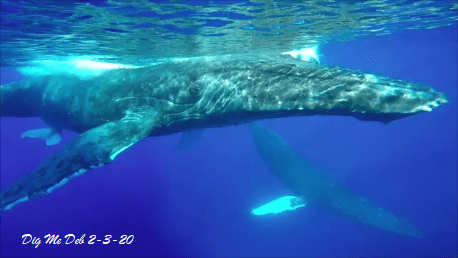February 3, off the coast of Maui, Hawaii: The captain of a whale-watching cruise observes three humpback whales. According to his account, he saw a female humpback accompanied by two presumed males. He deploys an underwater camera. Much to his surprise, he discovers that a tiny tail is sticking out of the female’s genital slit. She’s giving birth! This video footage is the first to partially show a humpback in the process of calving. This is an event that is seldom documented in nature.
With his engine turned off and his boat stationary, the captain shoots this underwater scene for an hour or so.. The calf does not seem to want to come out. The whales vocalize, which we can hear in the video. They circle the Zodiac. One of the escorts – the term used for whales accompanying a female during the breeding season – periodically produces bubble nets.
After the excursion boat departs, a research vessel belonging to the National Oceanic and Atmospheric Agency (NOAA) tracks the female for another hour before she disappears into the choppy sea. She has not been seen again since. It is therefore unknown whether or not she successfully managed to give birth.
Thanks to underwater images of her caudal fin, the female was able to be identified in the research catalogue of the Russian Cetacean Habitat Project as 10RUCO715. She had previously been photographed off Russia’s Kamchatka Peninsula in 2010. If she is seen and recognized again this winter in US waters or next summer in Russian waters, we will know whether she succeeded in giving birth and whether the calf survived.
How long does a birth take?
Good question! The calving process in whales in the wild is poorly documented. The majority of our knowledge on births comes from observations of whales in captivity. Most often, newborns are born tail first. This is believed to limit the risk of drowning by delaying the emergence of the blowhole as long as possible. However, head-first births have been observed in captive whales.
In aquariums, beluga deliveries can take up to 7.5 hours, but vary greatly in duration. Is this comparable to humpbacks in the wild? It’s hard to say.
According to our research, only one other case of a humpback giving birth has ever been documented, which was in Madagascar in 2013. The team was able to track the female beginning at 09:26. The female was in the company of male escorts. At the time, the researchers were unaware that a birth was about to take place. A ring of blood about 10 metres in diameter appeared on the surface at 10:16 and at 10:23, a calf appeared in the middle of this ring. The first breath occurred two minutes later and the female appeared at the surface at 10:27. The first underwater images were taken after 10:30, which means the situation cannot be compared to the one documented in Hawaii.
In 2019, researchers in Hawaii filmed the first few minutes of a humpback whale’s life after being alerted by a whale-watching outfitter. The captain had observed strong eddies, followed by blood at the surface. When researchers later managed to launch a drone and film the animals, the calf was swimming alongside its mother and a little more blood came out of the latter’s genital slit. The presence of fetal folds were evidence that the birth was very recent. These rare images document the early life of a humpback whale.
The female’s behaviour before, during and just after giving birth is still very poorly understood. The role of the humpbacks escorting her is just as much of an enigma. It is obviously even more difficult to get a sense of what a birth looks like from the surface. Nature still has many secrets to reveal!





